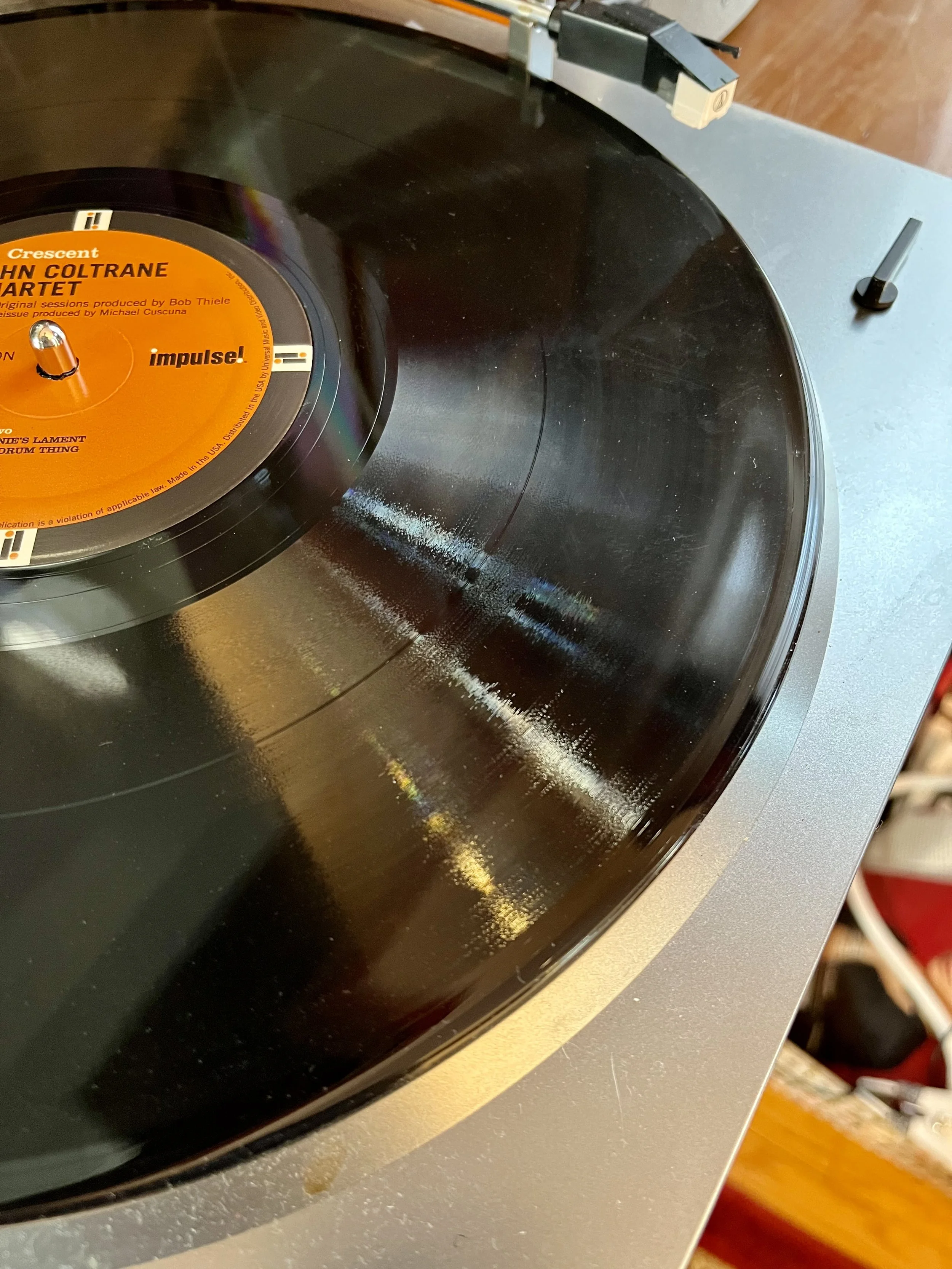Everyone seems to be interested in habit formation and neuroplasticity recently. The main images for describing these phenomena still used by psychologists are ‘firing and wiring’ (from Donald Hebb, The Organization of Behavior, 1949) and ‘pathways’ (William James, Principles of Psychology, 1890). James begins his chapter Habit by demonstrating that habits are physical in nature, formed by repeated actions, and maintained by the traveling of electrical impulses through the nervous system along pathways to and from the brain. Almost everything we do and think takes habitual form.
The more poetic or journalistic writers use images of erosion and industrial forms made by repetition: channels, grooves. A groove is a furrow, a ditch engineered to control what grows and flows, life and water.
Grooves have a positive valence these days, thanks to records and jazz. The phrase in the groove originated among jazz musicians in the 1920s. Musically, we move from the cathedral to the club, as grooves became the spiral channels cut inside organ pipes, in phonograph cylinders, on gramophone records, and finally vinyl.
Being in the groove, lost in the flow of music, is an experience of immersion and no-self and this context lent itself to the meanings of groove in the later twentieth century. A groove is “a pronounced enjoyable rhythm”; in verb form to groove is “to enjoy oneself intensely” and “to interact harmoniously” (M-W). The OED gets more explicit and cites examples from the 1960s when interacting harmoniously meant, more specifically, playing music well together, and “making love.”
Music like water flows in grooves and goes and takes us with it; the transports it can induce are like those of eroticism, which was one reason “grooviness” became countercultural and jazz, to the racist hegemons, a manifestation of sexual power and the threat they believed Black men to embody (see, e.g. “The White Reception of Jazz in America”).
Groove as flow defies death, denies the grave… or is the deepest acknowledgment of its inevitability, an intertwining Georges Bataille articulated in the first sentence of his book, Erotism: “Eroticism, it may be said, is assenting to life up to the point of death.” He saw in eroticism a drive toward the lost continuity and oneness that would come again in death. This intertwining is also in the word groove’s history and root. Being “in the groove” was an attitudinal change from the earlier meaning, from the mid-1800s, when being in a groove was being in a rut, a “narrow, limited, undeviating course” of life (OED) (what we now so often call “stuckness”), a meaning that points to groove’s etymological kinship with grave, both words stemming from Old Norse grof, pit. A rut may be easily mistaken for a groove, which is one reason some habits are so sticky—they seem sustaining, not depleting.
I wondered, at times, if I was in a groove or a rut. My life just took a turn that tuned me into habits as I’ve never been before. A dissonance between the new and the familiar, the now and the before, the present and the absent, has magnified small motions I make in my home as they slough meanings and are laid bare, before they’re layered over again with new interpretations. Emily Dickinson had something to say to me:
The Brain, within its Groove
Runs evenly—and true—
But let a Splinter swerve—
‘Twere easier for You—
To put a Current back—
When Floods have slit the Hills—
And scooped a Turnpike for Themselves—
And trodden out the Mills—
There’s a pleasure in running evenly—and true. When one is in the groove (a phrase which recently has become displaced by “in flow” because of the popularization of Mihaly Csikszentmihalyi’s 1990 book Flow), one is doing something complex with ease and a pleasureful feeling of transport or suspension; it’s an action that has been repeated so many times, through practice, and it has associated mind states that are comforting because familiar and because they fill one up with a lungful feeling of goodness and serenity. It’s the runner’s high, immersion, bliss.
The Brain within its Groove is comfortable and secure. It thinks it knows what to expect; thinks it has finally got it all figured out and is being validated by the universe because things are running smoothly. “But let a Splinter swerve—” and the truth of impermanence arrives. How perfect the half-rhyme of Groove and swerve is here. One the Groove itself, that thinks itself autonomous, self-justifying and -sufficient, correct, at ease; the other the dichotomous action that splinters the Groove, the rut, the habit, leading to flood and chaos.
Swerve is a perfect word here not only for the half-rhyme, but because in this poem it does what it means. To swerve is to suddenly follow a curving tangent off the main trajectory. A groove is a well-run path, and a swerve from it a casting off into untrodden territory (trodden in the second stanza becomes something done by water, as if water is a giant indifferent to the endeavors of humans).
And a Splinter is a sudden and slightly painful introjection. A foreign object that pierces and penetrates, releasing what was controlled, bringing the Floods.
Once a thought, an idea, a person has swerved its way in, you can’t go back.
As the last five lines say, it would be easier to put a river back where it came from, back in its groove after floods, than to go on as if that event had never occurred, because of its significance, its splintering effect on the brain’s groove, on the habit of the deepest sort. The landscape is changed.
We long to be in the groove. But we fear it too, because a mood becomes a mode, a groove a grave.
Change is life, life change. Chiasmus, reflection, mirror, suspension.
Quotes are from:
Merriam-Webster: groove
Oxford English Dictionary, groove.
Bataille, Georges, Erotism: Death and Sensuality, San Francisco: City Lights, 1982 (1957 in French; first English edition 1962).
Emily Dickinson, poem 556, composed c. 1862.

